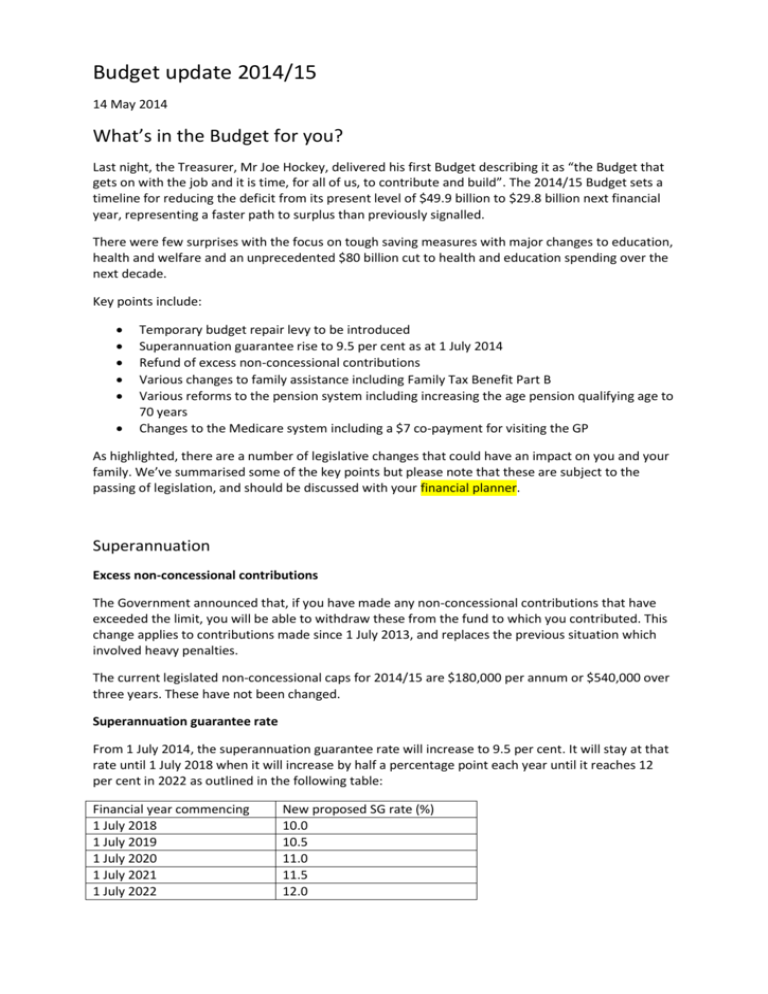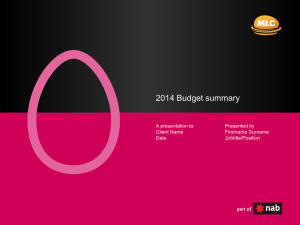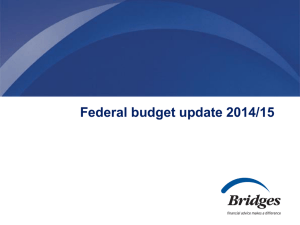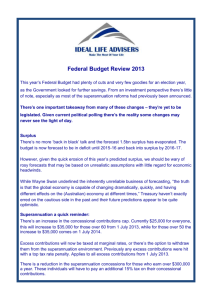Budget update 2014/15 14 May 2014 What's in the Budget for you
advertisement

Budget update 2014/15 14 May 2014 What’s in the Budget for you? Last night, the Treasurer, Mr Joe Hockey, delivered his first Budget describing it as “the Budget that gets on with the job and it is time, for all of us, to contribute and build”. The 2014/15 Budget sets a timeline for reducing the deficit from its present level of $49.9 billion to $29.8 billion next financial year, representing a faster path to surplus than previously signalled. There were few surprises with the focus on tough saving measures with major changes to education, health and welfare and an unprecedented $80 billion cut to health and education spending over the next decade. Key points include: Temporary budget repair levy to be introduced Superannuation guarantee rise to 9.5 per cent as at 1 July 2014 Refund of excess non-concessional contributions Various changes to family assistance including Family Tax Benefit Part B Various reforms to the pension system including increasing the age pension qualifying age to 70 years Changes to the Medicare system including a $7 co-payment for visiting the GP As highlighted, there are a number of legislative changes that could have an impact on you and your family. We’ve summarised some of the key points but please note that these are subject to the passing of legislation, and should be discussed with your financial planner. Superannuation Excess non-concessional contributions The Government announced that, if you have made any non-concessional contributions that have exceeded the limit, you will be able to withdraw these from the fund to which you contributed. This change applies to contributions made since 1 July 2013, and replaces the previous situation which involved heavy penalties. The current legislated non-concessional caps for 2014/15 are $180,000 per annum or $540,000 over three years. These have not been changed. Superannuation guarantee rate From 1 July 2014, the superannuation guarantee rate will increase to 9.5 per cent. It will stay at that rate until 1 July 2018 when it will increase by half a percentage point each year until it reaches 12 per cent in 2022 as outlined in the following table: Financial year commencing 1 July 2018 1 July 2019 1 July 2020 1 July 2021 1 July 2022 New proposed SG rate (%) 10.0 10.5 11.0 11.5 12.0 First home saver accounts The first home saver accounts scheme will be abolished from 1 July 2014. Taxation Temporary budget repair levy If you earn an income of $180,000 per annum or more, you will incur an additional two per cent levy on the amount earned over $180,000. For a period of three years only, commencing from 1 July 2014 and finishing on 30 June 2017, this will bring the top marginal tax rate to 47 per cent (plus the Medicare levy of two per cent). Fringe benefits tax (FBT) The FBT rate will increase from 47 per cent to 49 per cent from 1 April 2015 until 31 March 2017. This is to ensure that people earning over $180,000 don’t use salary packaging to avoid the additional impost associated with the temporary budget repair levy. If you are currently packaging a car this may impact you. Mature age workers tax offset This will be abolished from 1 July 2014 rather than being phased out. Dependent spouse tax offset This will be abolished from 1 July 2014. Centrelink and other Government benefits/payments Increasing the age pension qualifying age From 1 July 2025, the age pension qualifying age will start rising by six months every two years, from 67 years to 70 years by 1 July 2035. In effect, someone born after 1 January 1966 will not be able to apply for the age pension until 70. This does not mean you will need to work to age 70, just that you will need to rely on superannuation and other savings between retiring from the workforce and reaching age pension age. Date of birth between Age at which eligible for age pension 1 July 1952 and 31 December 1953 65½ 1 January 1954 and 30 June 1955 66 1 July 1955 and 31 December 1956 66½ 1 January 1957 and 30 June 1958 67 1 July 1958 and 31 December 1959 67½ 1 January 1960 and 30 June 1961 68 1 July 1961 and 31 December 1962 68½ 1 January 1963 and 30 June 1964 69 1 July 1964 and 31 December 1965 69½ 1 January 1966 and later 70 Resetting the deeming rate thresholds From September 2017, if you are a single pensioner, the Government will change the deeming rate thresholds by resetting them from $46,600 to $30,000 and from $77,400 to $50,000 if you are a pensioner couple. Current deeming rates mean that single income support recipients have certain financial assets of up to $46,600 deemed to earn income of 2 per cent and above $46,600 deemed to earn 3.5 per cent per annum. A lowering of the thresholds will ensure that more people are caught under the Centrelink income test. However, most Centrelink recipients are caught by the assets test and not the income test. Indexation of pension and other payments The indexation of pension and other equivalent payments will be linked to the consumer price index (CPI). This will apply from 1 July 2014 to Parenting Payment Single recipients and from 1 September 2017 to Bereavement Allowance and pension payments such as age pension, disability support pension, carer payment and veterans’ affairs pensions. Disability Support Pension (DSP) If you are a DSP recipient, the amount of time you can leave Australia and still receive the DSP will be reduced. The payment will be restricted to a maximum of four weeks in a 12 month period. The new rules apply from 1 January 2015, to existing and new applicants. This may significantly impact couples where one person is on the age pension and the other is on the DSP. Age pensioners are allowed to travel for up to 26 weeks in contrast to four weeks for DSP. Commonwealth Seniors Health Card From 1 July 2014, the current income levels for the Commonwealth Seniors Health Card (CSHC) will be indexed by the CPI. Currently, you may apply for the CSHC if you are single and earn less than $50,000 in adjusted taxable income per annum or a couple and earn less than $80,000 per annum. New applicants will have the full amount of any account-based pension included in the assessment for determining eligibility for the card. Previously, these tax-free pensions were not included in the assessment. Family payments From 1 July 2015, the Government will reduce the Family Tax Benefit Part B (FTB Part B) primary earner income limit from $150,000 to $100,000 per annum. While this will be limited to families whose youngest child is younger than six years of age, as a transitional arrangement, families with a youngest child aged six and over on 30 June 2015 will remain eligible for FTB Part B for two years. Other Health From 1 July 2015, bulk billed visits to General Practitioners, blood tests and XRays will cost the ordinary tax payer $7 per visit. Those on income support and children under 16 will also have to make a co-payment but it will be limited to the first ten visits. Pharmaceutical benefits scheme Co-payments will increase for general patients by $5.00 (from $37.70 to $42.70) and for concessional patients by $0.80 (from $6.10 to $6.90) in 2015. From 1 January 2015, PBS safety net thresholds will increase each year for four years. General safety net thresholds will increase by 10 per cent each year and concessional safety nets will increase by the cost of two prescriptions each year. These increases are in addition to the existing annual indexation of co-payments and safety net thresholds in line with the CPI. Universities – HECS and HELP From 1 June 2016, HECS and HELP assistance will remain available, however the interest rate will no longer be set at CPI but instead at the 10 year bond rate (albeit capped at six per cent). The minimum wage at which the debt will need to be repaid will also start earlier from 1 July 2016. Whilst HECS debt holders will be disappointed at this change, the interest rate charged is still extremely low and it may still be worthwhile deferring repayment in favour of reducing other nondeductible debt. Before making any decisions, you should talk to your financial planner about how these changes apply to you.






